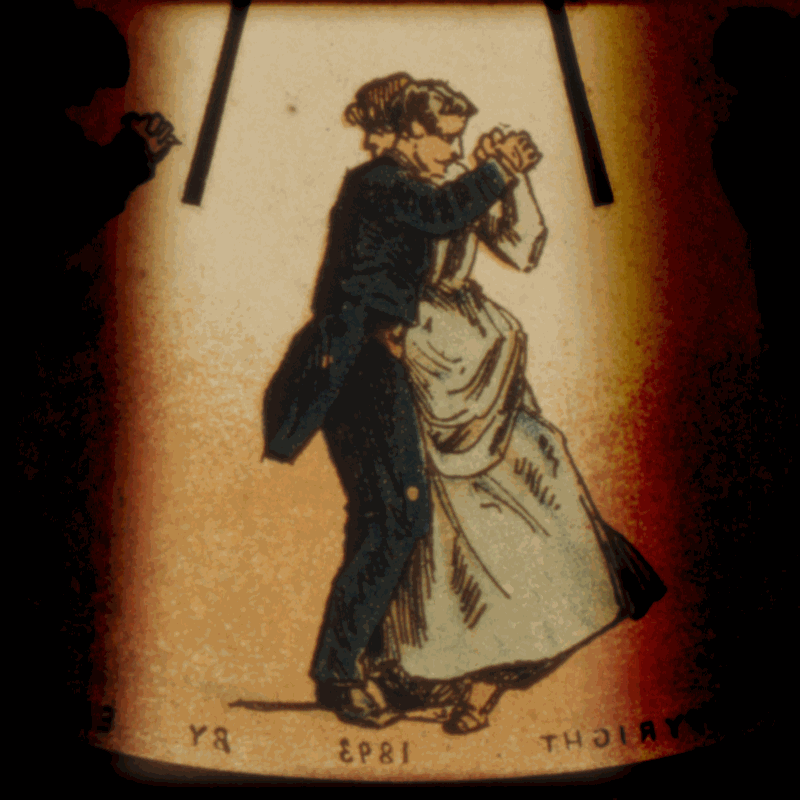
Gif illustrating how a Phenakistoscope works Image credit: Wikipedia
In adapting a book for film, a number of executive decisions are made: scenes are cut, metaphors are made visual, and wardrobes are custom fit to match the era or character’s personality, all to the chagrin or pleasure of the audience. While the conversation around film adaptation often happens with full-length feature films, it should be remembered that this is not solely a conversation worth having after the twentieth century. Of course, plays and even early forms of cinema have at times made more drastic and noteworthy changes when adapting a text for the stage or screen. In the early days of cinema, these changes were especially pronounced. Largely due to technological constraints, cinema couldn’t always replicate a narrative anywhere near its entirety – though in some ways it could do more. One consequence, especially visible in the sample that I use here, the short film Rip Van Winkle, is that the resulting adaptation has to tell the story in five fleeting scenes. In this post, I’ll offer an informational and technical overview of how one of the first film adaptations of a work of literature came to be, and in my follow-up posts I’ll offer more details about the Rip Van Winkle film itself, with a comparative analysis between the story and film.
Three forms of “moving pictures” preceded the Kinetoscope and Mutoscope, the technology used by Edison film, the company supposedly responsble for producing Rip Van Winkle. The first was the magic lantern. These were essentially early image projectors first developed in the 17th century. Through the use of tools like levers images would appear to “move.” Developed in the nineteenth century, there was the Phenakistoscope--a disc with successive images that, when spun, appeared to be moving. An early animation device that, in principle was like a cartoon flip book. Finally, there was the Zoopraxiscope – Developed by Eadward Muybridge in 1879, this device projected image series in successive phases of movement. They were either animated glass discs (similar to Phenakistoscope) or photographs. “Moving” photographs were made by strategically positioning multiple cameras along a subject’s line of movement.
The ingenious inventor of the Zoopraxiscope, Muybridge, approached Edison in 1888 with the suggestion that they collaborate, combining Muybridge’s Zoopraxiscope with Edison’s Phonograph. Edison found Muybridge’s plan inspiring but impractical. That same year Edison filed a caveat with the Patent’s Office of his plan to “do for the eye what the phonograph does for the ear.” His next invention, the Kinetoscope which was finally patented in 1892 emerged at the confluence of a group effort among Edison Studios assistants William Kennedy Laurie Dickson and others, along with the fortuitous advent of celluloid film sheets. Though Edison came up with the idea, modern scholars agree that the execution was almost entirely the result of Dickson’s efforts. The Kinetoscope was a large rectangular box containing film running vertically between two spools which would spin at a continuous rate. Through a viewer at the top, a spectator could peer in and view the film. The patent for the Kinetoscope was filed in 1891 and it was completed in 1892. The first Kinetoscope Parlor opened in 1894 in New York and featured five machines showing features for 25 cents apiece.
The Mutoscope patented by Herman Casler in 1894,was a simpler and more inexpensive “peep show” viewer similar to Edison’s Kinetoscope. It contained a rolodex-like series of photographs printed onto cardboard. The images were electrically illuminated and one person at a time could watch a film through a viewer at the top. It was owned by the American Mutoscope and Biograph Company and is the machine viewers used to watch the Rip Van Winkle film.[1]
From 1896-1900, a large number of films (with some exceptions) were “actuality” films featuring scenes of Vaudeville performers, celebrities, railway trains, and scenic places. In his 1894 biography on Edison, Dickson wrote that they were working on means to present “an entire play.” [2]
Stay tuned for my next post in which I'll discuss the actor chosen to play Rip, the ways in which scenes were divided, and more.
[1] MacGowan, Kenneth. “The Coming of Camera and Projector: Part II.” The Quarterly of Film Radio and Television 9. 2. (Winter, 1954): 124-136. University of California Press. Web. Feb. 9, 2013.
[2] Loughney, Patrick. “From ‘Rip Van Winkle’ to ‘Jesus of Nazareth’: Thoughts on the Origins of the AmericanScreenplay.” Film History 9. 3 Screenwriters and Screenwriting (1997): 277-289. Web. Feb 9, 2013.
Comments
A quick correction... :)
Although I love the way the sentence sounds (think about that statement for a second...heh, heh), the Edison quote should read "what the phoNograh does for the ear" instead of phoTograph. I normally wouldn't post grammer corrections but that one is pretty crucial. Still, I love how the mix of metaphores messes with my mind! ;) I love these posts about Rip Van Winkle. Thank you for posting! Very informative and interesting!
This was an interesting post...
...it intrigues me how a metaphor is made visual. Perhaps technological constraints reward more creative visual rethoric? Perhaps the ability to convey more information turns the message more unsophisticated yet more democratic?
Nice post :)